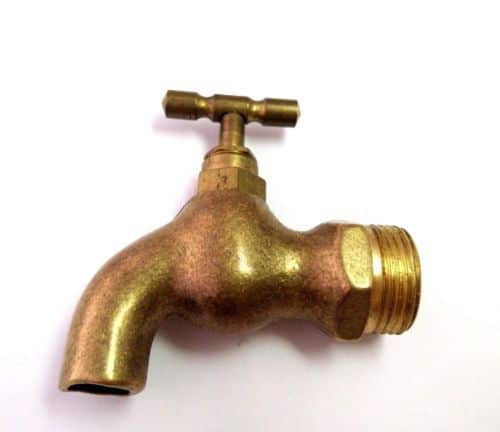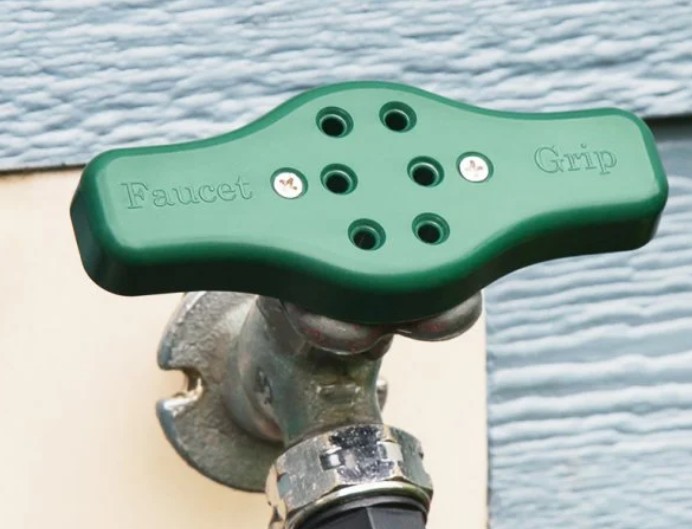Faucets are faucets, right? They all do the same thing, don’t they? So, what’s really the difference between indoor and outdoor ones? Well, their inner workings tend to be decidedly different from their inside cousins. Why? Because hot water isn’t an issue here.

On the other hand, they do have to be able to cope with adverse weather conditions without ruining themselves or causing havoc during cold times. Thankfully, there are several options of outdoor faucet types to choose from.
Let’s have a look at 10 different types of outdoor faucets and faucet handles for your garden or backyard.
Traditional Compression Valve or Spigot Faucet

Traditional compression valves are the ones that everyone will have seen before (unless you live in a freezing climate where these wouldn’t work).
They let the water from your house pass through the faucet’s opening once you turn the handle to the left. Therefore, turning it in the opposite direction will close it and stop the stream. Simple, right?
A good way to remember which way turns the faucet off and which turns it on is to chant this rhyme: “Lefty loosely, righty tighty”. It really does work!
Frost-Proof Outdoor Faucets
These are great if you live somewhere extremely cold (you know, like the northern countries or states in the USA).
Traditional compression valve faucets (the one we just talked about) can’t cope with harsh snow, frost and cold wind. Thus, their frost-proof brother was invented.
They stop the water from turning to ice and damaging your pipes or valves by implementing a metal tube that reaches into your house or outbuilding.
When the faucet is off, the valve keeps the water inside the warmer environment to stop it from freezing.
As long as it’s properly positioned, the water will drain towards the outside so there isn’t any water left in the pipe to cause damage. Just let this happen naturally. Don’t leave the hose attached as this won’t do you any favors.
Hose Bib Faucets
Otherwise known as sillcocks or spigots, hose bib faucets are generally put on the side of all homes as industry standard.
However, they can be pretty faulty — especially if you live in a super-cold area. They freeze under what some people would call mild conditions (bit of a shame really but after all, there are frost-proof variants for a reason).
Hose bibs work just like traditional compression valves. Don’t get us wrong, this isn’t a bad thing. It just means you can easily attach a frost-proof valve!
Ball-Valve Faucets
This type uses a ball (shocker!) that lives in the valve chamber. The ball itself has a single hole drilled into it to let the water through.
You won’t get as much control over the flow as you do with traditional compression ones. Having said this, it’s pretty perfect if you only need your water to be on or off and not somewhere in between.
FYI: They’re usually used in indoor plumbing too since it’s easy to shut them off without water dripping from the faucet’s head.
Yard Hydrants
These are brilliant for large outdoor areas that need sources of water far from your house or outbuildings. They tend to stick fairly far out of the ground with a riser pipe connecting the water supply to the spigot.
To use yard hydrants, you usually have to pull the handle located behind the spigot upwards. This starts the stream of water. From there, you can continue to lift the handle higher to encourage more water to spew from the end.
For best results, we suggest you install the frost-free variants (don’t worry, they’re easy to find). Then, you won’t have to worry about frost damage of any kind.
Anti-Siphon Faucets
Anti-siphon faucets (sometimes called backflow prevention solutions) are found in lots of outdoor plumbing.
The great thing about these is that they aren’t high-tech at all! You can purchase an anti-siphon valve and attach it yourself. It’s that easy. Although, you probably already have one since most faucets (the ones outside at least) come with one as standard.
So, what does it do? Well, this handy little valve stops contaminants from entering the water. Should these nasties find its way in there, pollution isn’t far behind.
In some locations, having an outdoor faucet without an anti-siphon valve is illegal. Be sure to check if you’re unsure about where you stand with this.
Outdoor Faucet Handle Types
Now let’s see some popular options for outdoor faucet handles that you can find in the market right now.
Round Wheel Handle
Round-wheel handles are probably the most popular type.
You can repair broken or worn-out faucets with this handle. It has a standard fit, and it is compatible with most outdoor faucets.
It has a large ergonomic design, so it is easier to use and more comfortable than the traditional faucet handles.
It is durable and made of metal that resists rust and corrosion, and it is reliable for lasting use. It comes with screws and adapters for a simple installation.
This faucet is easy for most people to use if they want to replace their faucets without the expense of bringing in a professional.
Hose Bibb Tee Handle
Another type that is found in outdoor faucets is the Tee Handle.
The one shown above is a simple tee handle, and it comes with a 12- or 16-point stem. It is designed for lawn faucets or valves, and it can be installed to replace most faucets of this type.
It has a square stem, and it is built to last. It is a small faucet attachment that usually is attached to a hose spigot.
It gives you easy access to the water, and it is very easy to use. This one is well built and durable, so it will last a long time once you install it.
Turn Hose Bibb Handle
This turn hose bibb handle is made of brass, and it has a female NPT X garden hose thread. It uses a quarter turn, and it has an easy-to-operate ball valve handle.
It has a full port design, which allows unrestricted waterflow no matter what you are doing. It is convenient because you only need to turn the handle a quarter turn for full access to water.
This is easier than having to turn a handle several rotations to get the higher pressure. This is a great handle choice for anyone who is looking for unrestricted waterflow and a simple solution.
Outdoor Faucet Handle for Better Grip

This is a larger handle for outdoor faucets, and it is easy to turn water on and off. It gives you additional leverage and provides a grippable surface.
It is great for anyone who has trouble with smaller metal handles. It will attach to most latticework hose bib faucet handles whether they are round or oval.
It also prevents dripping from a leaking faucet. It is made of durable ABS plastic, and it can handle extreme hot and cold weather.
Many people benefit from using this handle, including people who are suffering arthritis, have any hand soreness, or have trouble turning the smaller metal handles.
And There You Have It!
In a perfect world, all faucets would just work regardless of where they’re placed. But unfortunately, life isn’t quite that simple so we have a bunch of products that all do the same thing (relatively speaking).
Anyway, you’re basically a certified outdoor faucet expert now! Go forth and conquer all your outside faucet needs with ease.
Related Posts
- 6 Different Types of Soil for Gardening – How to Identify and Improve Each Type
- Landscaping with Rocks vs Mulch with Pros and Cons
- How to Create a Low Maintenance Garden
- 5 Benefits of Having Artificial Grass for Your Pets to Play On
- 12 Main Pros and Cons of a Pea Gravel Patio for Your Home
- Want to Redo Your Lawn? Here Are Your Options
Yo Glenn, the “Faucet Grip” is junk; a good idea, but junk, which you already know if you have tried to install one,
Larry, thanks for your comment.
I wouldn’t say its junk. It works fine especially on top of round faucet handles.
I am not able to find a replacement handle, any suggestions,? I have looked everywhere.
(__)
Does anyone know what the type of faucet this is:
Has a pipe running vertically into the ground, and at the top of the pipe, is a metal valve you lift up and down. The higher you lift up, the higher the water pressure. Wish I could post a picture of it..my description isn’t fabulous. Sorry!
I have an older faucet from the 60’s
It usually has a key to turn off & on.
What can I use to replace the key ???
have an outdoor water faucet,want to run a garden hose from it,to another faucet 30′ away on my deck. or something similar to turn the water on and off for my wife to water her plants. your advise would be greatly appeciated.
Bruce, for a more permanent solution I’d suggest to run an underground water pipe line such as HDPE pipes or PEX type pipes.